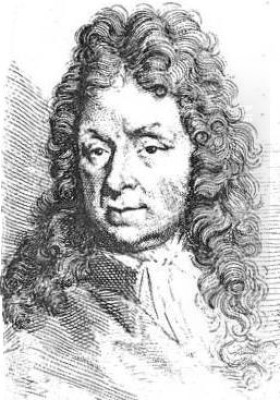
The Dutch Golden Age, spanning roughly the 17th century, was a period of extraordinary artistic flourishing in the Netherlands. While masters like Rembrandt van Rijn and Johannes Vermeer explored the human condition and the subtleties of light, other artists specialized, carving out unique niches within the burgeoning art market. Among the most celebrated of these specialists was Melchior de Hondecoeter, a painter whose vibrant and meticulously detailed depictions of birds earned him enduring fame and the admiring title "the Raphael of bird painters." His canvases, teeming with life, captured the beauty, drama, and sheer variety of the avian world, securing his place as the preeminent bird painter of his time.
An Artistic Dynasty: The Hondecoeter Family Legacy
Melchior de Hondecoeter was not the first artist in his family; he was born into a lineage already steeped in artistic tradition, originating from Flanders before settling in the Dutch Republic. His grandfather, Gillis Claesz. de Hondecoeter (c. 1575/1580–1638), was a respected landscape painter active primarily in Utrecht and later Amsterdam. Gillis specialized in wooded landscapes often populated with animals and birds, drawing influence from contemporaries like Roelant Savery. His works laid the foundation for the family's artistic direction, establishing an early interest in depicting the natural world.
The artistic mantle was passed to Melchior's father, Gijsbert Gillisz. de Hondecoeter (1604–1653). Gijsbert followed closely in his father's footsteps, also focusing on landscapes but developing a particular affinity for painting birds, especially waterfowl and domestic poultry within rustic settings. His style continued the family tradition, providing Melchior with his earliest artistic environment and likely his first informal instruction. The focus on birds became more pronounced with Gijsbert, setting the stage for his son's eventual specialization.
![The Floating Feather [detail #1] by Melchior de Hondecoeter](https://www.niceartgallery.com/imgs/186443/m/melchior-de-hondecoeter-the-floating-feather-detail-1-b4aafa8d.jpg)
Perhaps the most significant influence on Melchior's development, besides his father, was his uncle, Jan Baptist Weenix (1621–c. 1660/1661). Weenix was a highly versatile and successful painter who had spent several years in Italy. He excelled in various genres, including Italianate landscapes, portraits, and still lifes, particularly dead game. His style was characterized by a richer palette, dramatic lighting, and a more decorative, sometimes flamboyant, approach influenced by his Italian sojourn. After Gijsbert de Hondecoeter's death in 1653, the young Melchior continued his training under his accomplished uncle, absorbing Weenix's sophisticated technique and penchant for elegant compositions.
Early Life and Training in Utrecht and The Hague
Melchior de Hondecoeter was born in Utrecht around 1636. Growing up surrounded by the tools and talk of painting, his path seemed almost predestined. His initial artistic education came from his father, Gijsbert, who would have introduced him to the fundamentals of drawing and painting, likely focusing on the landscape and animal subjects favored by the family. Utrecht, at the time, was a significant artistic center, known particularly for the Utrecht Caravaggisti like Gerard van Honthorst and Hendrick ter Brugghen, although their dramatic, figure-focused style seems to have had less direct impact on the Hondecoeter lineage than the landscape tradition.
The death of his father in 1653 marked a turning point. Melchior, then about seventeen, came under the tutelage of his uncle, Jan Baptist Weenix. This period was crucial for shaping Melchior's mature style. Weenix's broader experience, including his time in Italy and his mastery of different textures and lighting effects, significantly expanded Melchior's artistic horizons beyond the more localized style of his father and grandfather. He learned to handle paint more fluidly, to compose more complex scenes, and likely developed his taste for incorporating exotic elements, a hallmark of Weenix's later work.
By 1659, Hondecoeter had moved to The Hague, a city that served as the administrative center of the Dutch Republic and a hub for artists. There, he joined the Confrerie Pictura, the city's guild or confraternity of painters. Membership in such an organization was essential for artists wishing to practice professionally, take on pupils, or sell their work legally within the city. His entry into the guild signifies his arrival as an independent master. His period in The Hague, lasting until 1663, saw him further refine his skills and begin establishing his reputation, likely focusing increasingly on the bird paintings that would become his specialty.
Amsterdam: The Pinnacle of a Career
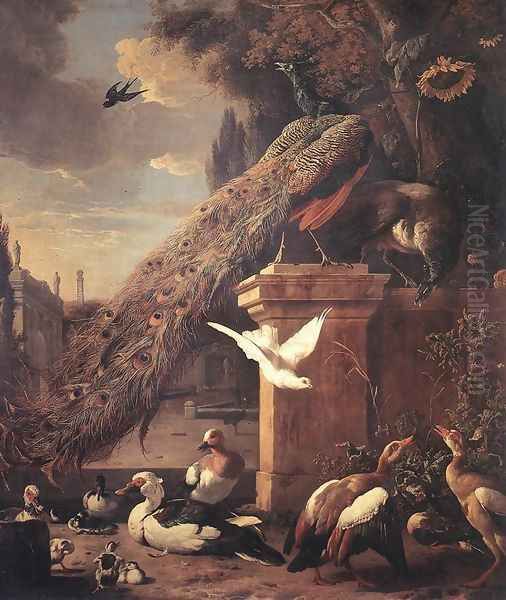
In 1663, Melchior de Hondecoeter made a decisive move to Amsterdam, the vibrant commercial and cultural heart of the Dutch Republic. This relocation marked the beginning of the most productive and successful phase of his career. Amsterdam, with its wealthy merchant class, burgeoning international trade, and sophisticated art market, offered unparalleled opportunities for an ambitious artist. Hondecoeter quickly established himself, becoming a citizen (burgher) of Amsterdam that same year, a status often necessary for full participation in the city's economic and social life. He married Susanna Tradel in Amsterdam in 1663, further cementing his ties to the city.
Amsterdam provided Hondecoeter with a discerning clientele eager for his specialized art. His paintings of birds, ranging from familiar domestic fowl to exotic species newly arriving in the Netherlands via trade routes, perfectly suited the tastes of affluent burghers and aristocrats. These patrons sought artworks that reflected their wealth, worldliness, and appreciation for the beauty of nature, albeit often a carefully curated version of it. Hondecoeter's large-scale, decorative canvases were particularly well-suited for adorning the walls of grand townhouses and country estates.
Among his most prestigious patrons was Stadtholder William III, later King William III of England. Hondecoeter received commissions to create paintings for William's palaces, including Soestdijk Palace, Honselaarsdijk, and Het Loo Palace near Apeldoorn. These royal commissions underscore the high esteem in which Hondecoeter was held. His works for these residences were often designed as integral parts of the interior decoration, sometimes functioning as overmantel pieces or wall panels, demonstrating his ability to tailor his art to specific architectural contexts. He remained in Amsterdam for the rest of his life, working prolifically until his death in 1695.
The Hondecoeter Style: Realism, Drama, and Decoration
Melchior de Hondecoeter developed a distinctive and highly recognizable style that blended meticulous realism with dramatic composition and decorative flair. His primary subject was birds, rendered with an astonishing degree of accuracy. He possessed a keen observational skill, capturing the specific anatomy, plumage, posture, and even the perceived character of each species. His rendering of feathers was particularly masterful, conveying their softness, iridescence, or ruffled texture with convincing stofuitdrukking (the Dutch term for the realistic representation of textures).
While realism was fundamental, Hondecoeter's paintings were rarely mere ornithological studies. He infused his scenes with life and drama. Birds are shown interacting – feeding, preening, squabbling, courting, or tending to their young. He often depicted moments of conflict, such as cockfights or birds of prey attacking poultry, creating dynamic focal points within his compositions. This narrative element, sometimes bordering on anthropomorphism, made his works engaging and lively, moving beyond simple representation.
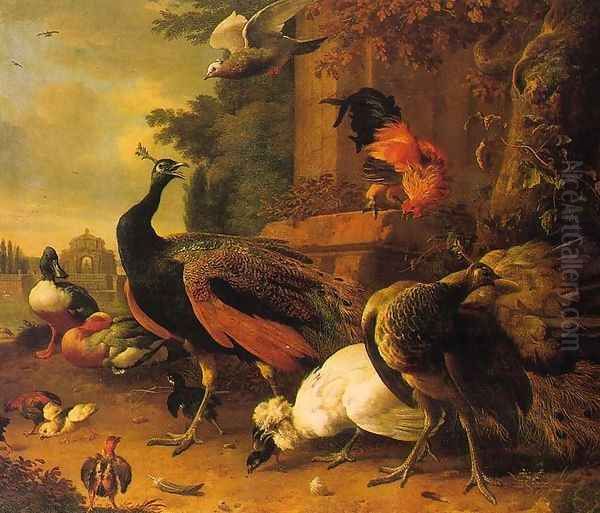
His compositions were often complex and ambitious, especially in his larger works. He typically arranged birds in lively groups within a specific setting, often a farmyard, parkland, or the grounds of a country estate, sometimes featuring classical architectural elements or distant landscape views. He frequently employed a low viewpoint, making the birds appear monumental and emphasizing their presence. This technique, combined with the large scale of many of his canvases, gave his works a commanding presence suitable for decorative schemes in grand interiors.
The influence of his uncle, Jan Baptist Weenix, is evident in the decorative quality of Hondecoeter's work and his use of light and color. He employed a rich, vibrant palette to capture the brilliant plumage of exotic birds like peacocks and parrots. His handling of light often created dramatic contrasts, highlighting key figures and adding depth to the scene, reminiscent of the Italianate style Weenix had mastered. He also shared with Weenix an interest in depicting luxury and abundance, whether through the inclusion of exotic species or the overall sense of a well-stocked, thriving environment. Furthermore, the influence of Flemish Baroque animal painters, particularly Frans Snyders, known for his large-scale, energetic depictions of animals and hunts, can be seen in the dynamism and scale of Hondecoeter's compositions.
A Menagerie on Canvas: Signature Themes and Subjects
Hondecoeter's artistic world revolved almost exclusively around birds. His repertoire was vast, encompassing a wide array of species, both native to the Netherlands and exotic imports that fascinated the Dutch public. Domestic fowl were a recurring theme, with chickens, ducks, geese, and turkeys populating many of his canvases, often depicted in bustling farmyard scenes. These familiar birds were rendered with the same care and detail as their more exotic counterparts, often shown interacting in lively, naturalistic ways – hens protectively gathering their chicks, roosters crowing assertively, ducks paddling in ponds.
Game birds, such as pheasants, partridges, and pigeons, also featured prominently, reflecting the aristocratic pursuits of hunting and the appreciation of nature's bounty. These birds were often shown in park-like settings or woodlands, sometimes alongside domestic fowl, creating a blend of the wild and the cultivated.
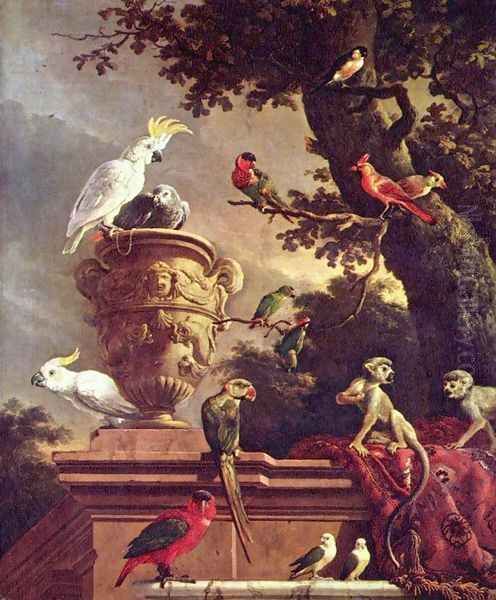
However, Hondecoeter is perhaps best known for his magnificent depictions of exotic birds. Peacocks, with their iridescent plumage and regal bearing, were a particular favorite, often serving as the centerpiece of his compositions, symbolizing pride, luxury, and immortality. He also painted pelicans, flamingos, cranes, parrots, cockatoos, and even rarer species like the cassowary, reflecting the global reach of Dutch trade and the burgeoning interest in natural history collections (menageries) among the wealthy. These exotic birds added an element of wonder and opulence to his paintings, transforming simple poultry yards into scenes of cosmopolitan splendor.
The settings for his avian dramas were carefully chosen. While some paintings feature simple, rustic farmyards, many depict the more manicured environments of country estates or idealized parklands. Balustrades, classical urns, fountains, and glimpses of formal gardens or grand architecture often appear in the background, situating the birds within a context of aristocratic life and leisure. Water, whether a simple pond or an ornamental basin, was frequently included, allowing him to depict waterfowl and reflections, adding another layer of visual interest and realism. These settings not only provided a backdrop but also enhanced the decorative function of his paintings, making them suitable for elegant interiors.
Masterpieces in Focus: Key Works Explored
Several paintings stand out as exemplary of Melchior de Hondecoeter's skill and signature style. The Floating Feather (c. 1680, Rijksmuseum, Amsterdam) is perhaps his most famous work. It depicts a tranquil scene by a pond, featuring a pelican, cranes, ducks, and other waterfowl. The painting is renowned for its serene atmosphere and the incredible detail, particularly the single, delicate feather floating on the water's surface near the foreground, which gives the work its name. The composition is balanced, the light soft, and the rendering of textures – feathers, water, foliage – is masterful. It showcases Hondecoeter's ability to create a peaceful yet visually rich scene.
Peacocks (1683, Metropolitan Museum of Art, New York) exemplifies his fascination with exotic birds and his decorative prowess. Two magnificent peacocks dominate the composition, one displaying its full train in a dazzling array of color and pattern. Other birds, including a peahen, pigeons, and a magpie, surround them within a setting suggestive of a stately park, complete with classical architecture in the background. The painting is a celebration of natural beauty and opulence, rendered with vibrant colors and meticulous attention to the texture of the feathers. It highlights his skill in creating large, impactful compositions suitable for aristocratic patrons.
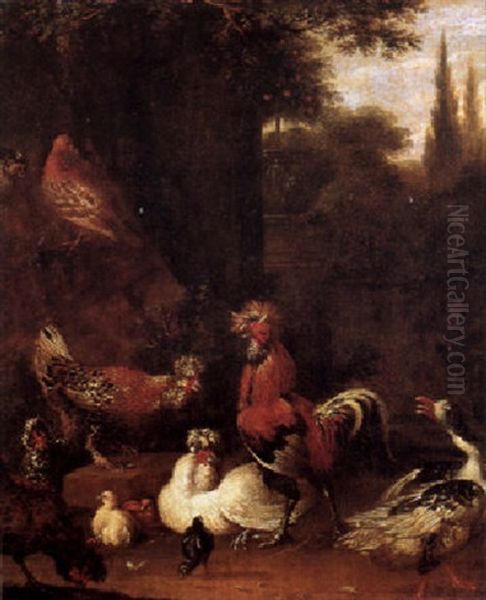
His numerous depictions of poultry yards, often simply titled A Poultry Yard or The Poultry Yard (examples in the Rijksmuseum, Wallace Collection, London, and elsewhere), represent a core theme. These works typically show a lively gathering of chickens, ducks, turkeys, and pigeons in a farmyard setting. Hondecoeter excels at capturing the individual character and interactions of the birds – a strutting rooster, a protective hen with chicks, squabbling geese. These scenes, while depicting common subjects, are elevated by his technical skill and dynamic compositions, often including a glimpse of a landscape or building to provide context.
Paintings depicting conflict, such as The Fight Between the Cock and the Turkey or scenes where birds of prey attack poultry, showcase Hondecoeter's ability to capture drama and movement. These works are characterized by energetic compositions, dynamic poses, and a focus on the intensity of the struggle. They demonstrate a different facet of his art, moving beyond serene observation to depict the more violent aspects of nature, perhaps serving as allegories or simply catering to a taste for dramatic narratives. These varied examples illustrate the range within Hondecoeter's specialization, from tranquil scenes to dramatic encounters, all unified by his exceptional technical skill and focus on the avian world.
Patronage and Prestige: The Painter of Princes and Patricians
Melchior de Hondecoeter's success was built upon his ability to attract and retain a wealthy and influential clientele. His specialization in bird painting, executed with unparalleled skill and decorative appeal, resonated strongly with the tastes of the Dutch elite during the Golden Age. His patrons included members of the aristocracy, powerful merchants, and even the head of state, Stadtholder William III.
The commissions from William III for his royal palaces were particularly significant, cementing Hondecoeter's status as a painter of the highest rank. Works created for Het Loo, Soestdijk, and Honselaarsdijk were often large-scale and designed to be integrated into the overall decorative scheme of specific rooms. These paintings served not only as art objects but also as symbols of the Prince's power, sophistication, and connection to the land and its natural bounty (including exotic imports). The presence of Hondecoeter's work in these prestigious settings undoubtedly enhanced his reputation and desirability among other wealthy patrons.
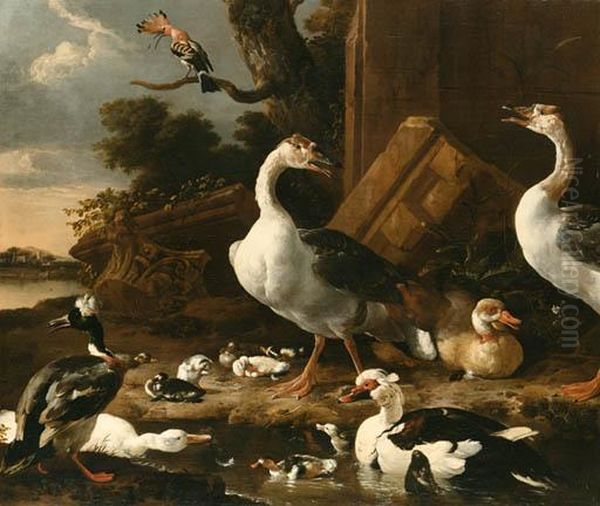
Beyond royalty, Hondecoeter found eager buyers among the affluent patrician class of Amsterdam and other Dutch cities. These merchants and regents, enriched by trade and finance, were keen to display their status through art collecting. Hondecoeter's paintings, with their depictions of both local fowl and expensive exotic birds, perfectly mirrored the patrons' own blend of domestic prosperity and global connections. The large size of many of his works made them ideal for the spacious interiors of canal houses and country estates, where they functioned as impressive decorative statements.
His fame was not confined to the Netherlands. His works were also highly sought after by English aristocrats, particularly after William III ascended to the English throne. The taste for Dutch art was strong in England, and Hondecoeter's detailed and lively bird paintings appealed to the English love of country life and natural history. His paintings became fashionable additions to English country house collections, further broadening his international reputation. The consistent demand from such high-status patrons throughout his career underscores the perfect alignment of his artistic output with the aesthetic preferences and social aspirations of the 17th-century elite.
Connections and Contemporaries: Hondecoeter in the Dutch Art World
While Melchior de Hondecoeter specialized intensely, he operated within the rich and diverse artistic landscape of the Dutch Golden Age. His career overlapped with many of the era's greatest masters, providing a context for his unique contribution. Although direct collaborations seem rare, his work can be understood in relation to the broader trends and other specialists of the time.
His most direct artistic relationships were within his own family – his grandfather Gillis, his father Gijsbert, and especially his uncle and teacher Jan Baptist Weenix. His cousin, Jan Weenix (son of Jan Baptist), also became a renowned painter, specializing in still lifes, particularly dead game and flowers, often continuing the decorative, Italianate style of his father. Melchior and Jan Weenix represent the continuation and refinement of the family's artistic traditions into the later 17th century.
In the broader context of animal painting, Hondecoeter stands out for his focus on live birds. While Flemish painters like Frans Snyders and Jan Fyt excelled in dynamic hunting scenes and still lifes featuring dead game, Hondecoeter concentrated on the depiction of living creatures in their environments. Within the Dutch context, Paulus Potter was famous for his realistic paintings of cattle and farm animals, often set in detailed Dutch landscapes. Adriaen van de Velde also skillfully incorporated animals into his landscapes. Hondecoeter's niche was specifically the portrayal of birds with unprecedented detail and liveliness.
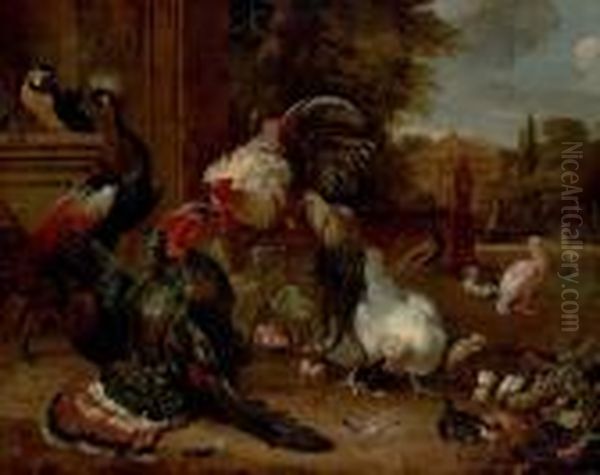
His contemporaries in other genres included the towering figures of Rembrandt and Vermeer, whose explorations of human psychology and light differed greatly from Hondecoeter's focus. Genre painters like Jan Steen, Gabriel Metsu, and Gerard Dou captured scenes of daily Dutch life, while landscape painters such as Jacob van Ruisdael and Meindert Hobbema depicted the Dutch countryside. Still life painting flourished with artists like Willem Kalf, Willem Claesz. Heda, and Abraham van Beijeren creating opulent displays, and specialists like Rachel Ruysch and Otto Marseus van Schrieck focused on flowers and forest floor scenes (sottobosco), respectively. Hondecoeter's work, while specialized, shared the era's commitment to realism, detailed observation, and technical mastery.
Beyond the Birds: Anecdotes and Lesser-Known Aspects
While Melchior de Hondecoeter is overwhelmingly known for his bird paintings, a few details and anecdotes add nuance to his biography. The nickname "Raphael of bird painters" speaks volumes about the esteem in which his technical skill and compositional harmony were held by contemporaries and later critics, comparing him to one of the High Renaissance masters.
There is some speculation, though not definitively proven, that Hondecoeter may have occasionally painted seascapes early in his career. This suggestion arises partly from the fact that his father and grandfather sometimes included water elements prominently, and marine painting was a popular genre in the Netherlands. However, no confirmed seascapes by Melchior are known, and his reputation rests entirely on his avian subjects. If he did experiment with marine themes, it was likely a minor or early aspect of his work.
Regarding his personal life, after moving to Amsterdam in 1663, he married Susanna Tradel. The couple lived in the Jordaan district, a bustling area known for its artisans and tradespeople. They had children, and records indicate his daughter Isabel inherited his property upon his death. However, historical accounts, notably by the early art biographer Arnold Houbraken, suggest that Hondecoeter may have experienced financial difficulties towards the end of his life. Houbraken mentions that the artist enjoyed frequenting taverns and that his wife managed his finances. Upon his death in 1695, he reportedly left debts, which his son-in-law, mentioned as a fellow artist who had married Isabel, eventually settled. These details offer a glimpse into the personal circumstances behind the successful artistic career.
His dedication to his craft was reportedly intense. Legend has it that he trained a rooster to stand still and pose for him on command, allowing him to study its form and plumage in detail. While likely apocryphal, such stories highlight the perceived realism and lifelike quality of his work, suggesting an intimate and dedicated study of his subjects.
Enduring Legacy: Influence and Collections
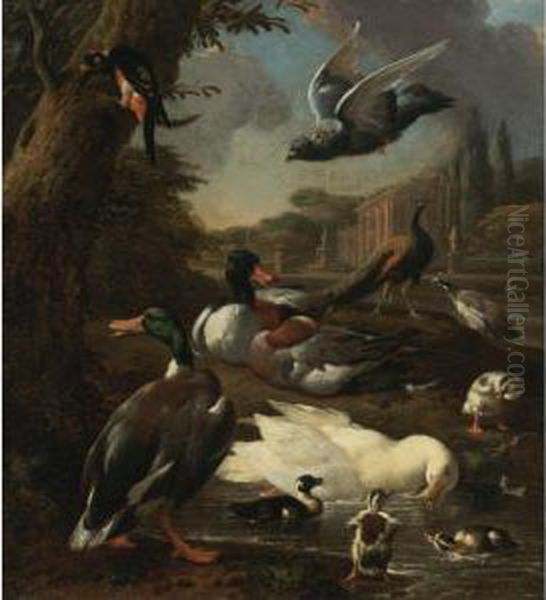
Melchior de Hondecoeter's impact extended beyond his own lifetime. His mastery in depicting birds set a standard that influenced subsequent generations of animal painters, particularly in the 18th century. In France, artists like Jean-Baptiste Oudry (1686–1755), known for his royal hunting scenes, animal paintings, and designs for the Beauvais and Gobelins tapestry manufactories, clearly drew inspiration from Hondecoeter's compositions and detailed realism. Other French animal painters, such as Nicolas Huet and Alexandre-François Desportes, also show an awareness of his work. Hondecoeter's paintings, present in prominent collections, served as models for artists specializing in animal and decorative painting.
While he doesn't seem to have had a large workshop with numerous formal pupils in the way some contemporaries did, his influence was disseminated through the widespread admiration and collection of his works. His paintings became staples in major European collections, both private and public.
Today, Melchior de Hondecoeter's works are held by many of the world's leading museums. The Rijksmuseum in Amsterdam holds a significant collection, including the iconic The Floating Feather and several fine examples of his poultry yards. The Wallace Collection in London boasts several excellent Hondecoeters. Other major institutions housing his paintings include the Metropolitan Museum of Art in New York, the State Hermitage Museum in St. Petersburg, the Gemäldegalerie Alte Meister in Kassel, the Gemäldegalerie in Berlin, the Victoria and Albert Museum in London, the Museum of Fine Arts in Boston, the Royal Castle in Warsaw, and many others across Europe and North America. The continued presence and popularity of his works in these prestigious collections testify to his enduring appeal and historical importance.
Conclusion: The Unrivaled Painter of Plumage
Melchior de Hondecoeter stands as a unique figure in the constellation of Dutch Golden Age masters. By dedicating his exceptional talents almost exclusively to the depiction of birds, he achieved a level of mastery and recognition in his chosen niche that remains unparalleled. His paintings are a testament to the era's fascination with the natural world, its burgeoning global connections, and its appetite for art that combined meticulous realism with decorative splendor.
From the familiar bustle of the poultry yard to the exotic majesty of peacocks and pelicans, Hondecoeter captured the avian world with unparalleled vibrancy, detail, and often, drama. He inherited an artistic legacy but forged his own distinct style, blending Dutch realism with Italianate flair learned from his uncle, Jan Baptist Weenix, and rivaling the dynamism of Flemish masters like Frans Snyders. Patronized by princes and patricians, his works adorned the grandest homes in the Netherlands and beyond, serving as both status symbols and sources of visual delight. Though he faced personal challenges, his artistic legacy, preserved in major museums worldwide, continues to captivate viewers with its feathered brilliance, securing his title as the undisputed "King of Bird Painters."